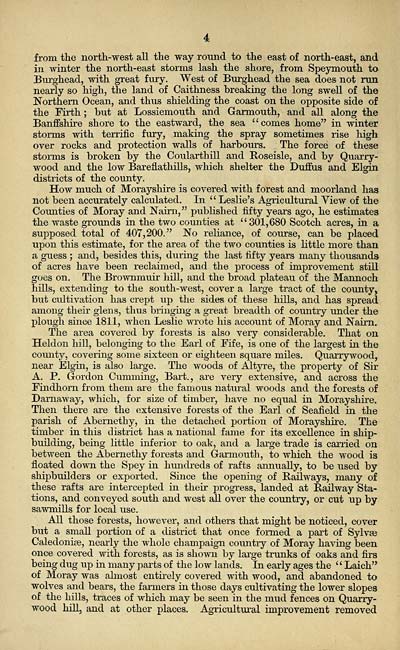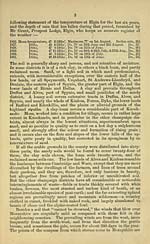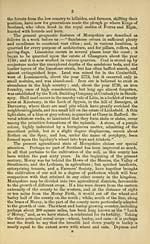Counties > Moray (Elgin) and Nairn Shires > 1863 - Black's Morayshire directory, including the upper district of Banffshire
(16)
Download files
Complete book:
Individual page:
Thumbnail gallery: Grid view | List view

from the north-west all the way round to the east of north-east, and
in winter the north-east storms lash the shore, from Speymouth to
Burghead, with great fury. West of Burghead the sea does not run
nearly so high, the land of Caithness breaking the long swell of the
Northern Ocean, and thus shielding the coast on the opposite side of
the Firth ; but at Lossiemouth and Garmouth, and all along the
Banffshire shore to the eastward, the sea "comes home" in winter
storms with terrific fury, making the spray sometimes rise high
over rocks and protection walls of harbours. The force of these
storms is broken by the Coularthill and Roseisle, and by Quarry-
wood and the low Bareflathills, which shelter the Duffus and Elgin
districts of the county.
How much of Morayshire is covered with forest and moorland has
not been accurately calculated. In " Leslie's Agricultural View of the
Counties of Moray and Nairn," published fifty years ago, he estimates
the waste grounds in the two counties at "301,680 Scotch acres, in a
supposed total of 407,200." No reliance, of course, can be placed
upon this estimate, for the area of the two counties is little more than
a guess ; and, besides this, during the last fifty years many thousands
of acres have been reclaimed, and the process of improvement still
goes on. The Brownmuir hill, and the broad plateau of the Mannoch
hills, extending to the south-west, cover a large tract of the county,
but cultivation has crept up the sides of these hills, and has spread
among their glens, thus bringing a great breadth of country under the
plough since 1811, when Leslie wrote his account of Moray and Nairn.
The area covered by forests is also very considerable. That on
Heldon hill, belonging to the Earl of Fife, is one of the largest in the
county, covering some sixteen or eighteen square miles. Quarrywood,
near Elgin, is also large. The woods of Altyre, the property of Sir
A. P. Gordon dimming, Bart., are very extensive, and across the
Findhorn from them are the famous natural woods and the forests of
Darnaway, which, for size of timber, have no equal in Morayshire.
Then there are the extensive forests of the Earl of Seafield in the
parish of Abernethy, in the detached portion of Morayshire. The
timber in this district has a national fame for its excellence in ship-
building, being little inferior to oak, and a large trade is carried on
between the Abernethy forests and Garmouth, to which the wood is
floated down the Spey in hundreds of rafts annually, to be used by
shipbuilders or exported. Since the opening of Railways, many of
these rafts are intercepted in their progress, landed at Railway Sta-
tions, and conveyed south and west all over the country, or cut up by
sawmills for local use.
All those forests, however, and others that might be noticed, cover
but a small portion of a district that once formed a part of Sylvse
Caledonise, nearly the whole champaign country of Moray having been
once covered with forests, as is shown by large trunks of oaks and firs
being dug up in many parts of the low lands. In early ages the ' ' Laich"
of Moray was almost entirely covered with wood, and abandoned to
wolves and bears, the farmers in those days cultivating the lower slopes
of the hills, traces of which may be seen in the mud fences on Quarry-
wood hill, and at other places. Agricultural improvement removed
in winter the north-east storms lash the shore, from Speymouth to
Burghead, with great fury. West of Burghead the sea does not run
nearly so high, the land of Caithness breaking the long swell of the
Northern Ocean, and thus shielding the coast on the opposite side of
the Firth ; but at Lossiemouth and Garmouth, and all along the
Banffshire shore to the eastward, the sea "comes home" in winter
storms with terrific fury, making the spray sometimes rise high
over rocks and protection walls of harbours. The force of these
storms is broken by the Coularthill and Roseisle, and by Quarry-
wood and the low Bareflathills, which shelter the Duffus and Elgin
districts of the county.
How much of Morayshire is covered with forest and moorland has
not been accurately calculated. In " Leslie's Agricultural View of the
Counties of Moray and Nairn," published fifty years ago, he estimates
the waste grounds in the two counties at "301,680 Scotch acres, in a
supposed total of 407,200." No reliance, of course, can be placed
upon this estimate, for the area of the two counties is little more than
a guess ; and, besides this, during the last fifty years many thousands
of acres have been reclaimed, and the process of improvement still
goes on. The Brownmuir hill, and the broad plateau of the Mannoch
hills, extending to the south-west, cover a large tract of the county,
but cultivation has crept up the sides of these hills, and has spread
among their glens, thus bringing a great breadth of country under the
plough since 1811, when Leslie wrote his account of Moray and Nairn.
The area covered by forests is also very considerable. That on
Heldon hill, belonging to the Earl of Fife, is one of the largest in the
county, covering some sixteen or eighteen square miles. Quarrywood,
near Elgin, is also large. The woods of Altyre, the property of Sir
A. P. Gordon dimming, Bart., are very extensive, and across the
Findhorn from them are the famous natural woods and the forests of
Darnaway, which, for size of timber, have no equal in Morayshire.
Then there are the extensive forests of the Earl of Seafield in the
parish of Abernethy, in the detached portion of Morayshire. The
timber in this district has a national fame for its excellence in ship-
building, being little inferior to oak, and a large trade is carried on
between the Abernethy forests and Garmouth, to which the wood is
floated down the Spey in hundreds of rafts annually, to be used by
shipbuilders or exported. Since the opening of Railways, many of
these rafts are intercepted in their progress, landed at Railway Sta-
tions, and conveyed south and west all over the country, or cut up by
sawmills for local use.
All those forests, however, and others that might be noticed, cover
but a small portion of a district that once formed a part of Sylvse
Caledonise, nearly the whole champaign country of Moray having been
once covered with forests, as is shown by large trunks of oaks and firs
being dug up in many parts of the low lands. In early ages the ' ' Laich"
of Moray was almost entirely covered with wood, and abandoned to
wolves and bears, the farmers in those days cultivating the lower slopes
of the hills, traces of which may be seen in the mud fences on Quarry-
wood hill, and at other places. Agricultural improvement removed
Set display mode to: Large image | Transcription
Images and transcriptions on this page, including medium image downloads, may be used under the Creative Commons Attribution 4.0 International Licence unless otherwise stated. ![]()
| Scottish Post Office Directories > Counties > Moray (Elgin) and Nairn Shires > Black's Morayshire directory, including the upper district of Banffshire > (16) |
|---|
| Permanent URL | https://digital.nls.uk/85597053 |
|---|
| Description | Directories of individual Scottish counties or parts of counties. |
|---|
| Description | Around 700 Scottish directories published annually by the Post Office or private publishers between 1773 and 1911. Most of Scotland covered, with a focus on Edinburgh, Glasgow, Dundee and Aberdeen. Most volumes include a general directory (A-Z by surname), street directory (A-Z by street) and trade directory (A-Z by trade). |
|---|


